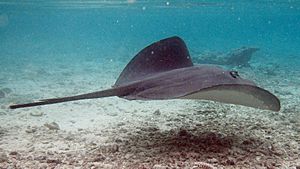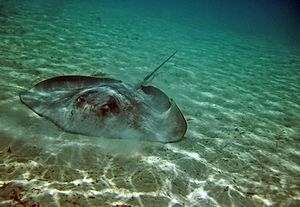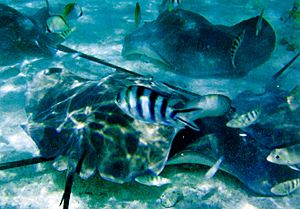Pink whipray facts for kids
Quick facts for kids Pink whipray |
|
|---|---|
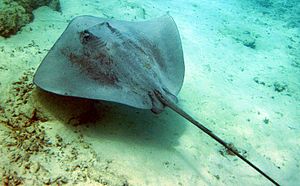 |
|
| Conservation status | |
| Scientific classification | |
| Genus: |
Pateobatis
|
| Species: |
fai
|
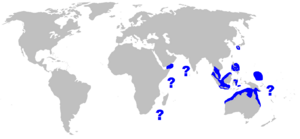 |
|
| Range of the pink whipray | |
The pink whipray (Himantura fai) is a type of stingray found in warm, tropical waters. It lives in the Indo-Pacific region, stretching from southern Africa all the way to Polynesia. This ray is a bottom dweller, meaning it lives near the ocean floor. You can usually find it in shallow areas, less than 70 meters (230 feet) deep, often in sandy spots close to coral reefs. Pink whiprays tend to stay in the same local areas and don't move around much.
This large ray has a unique diamond-shaped body that is wider than it is long. It has a broad snout and a very long, thin tail that looks like a whip. Unlike some other rays, its tail doesn't have fin folds. It has only a few small bumps on its back. The pink whipray is usually brownish to grayish pink, but its tail becomes much darker after the sting. These impressive rays can grow quite large, reaching up to 1.8 meters (6 feet) across and over 5 meters (16 feet) long!
Pink whiprays are social animals and often gather in large groups to rest or be active. They have even been seen hanging out with other big ray species. They mostly eat prawns, but also enjoy other small creatures that live on the seabed, as well as bony fishes. Baby pink whiprays grow inside their mother, getting special "uterine milk" for food. People sometimes catch these rays by accident while fishing. Their meat, skin, and cartilage are used. They are also popular for ecotourism, where people can see them up close. The International Union for the Conservation of Nature (IUCN) says the pink whipray is a "Vulnerable" species in some areas, like Southeast Asia, because of heavy fishing. However, in places like northern Australia, their numbers are more stable.
Contents
What's in a Name?
The pink whipray was first described by two American scientists, David Starr Jordan and Alvin Seale, in 1906. They studied a specimen that was about 37 centimeters (15 inches) wide, found near Apia, Samoa.
The second part of its scientific name, fai, means "stingray" in the local languages of places like Samoa, Tonga, and Tahiti. This is why another common name for this ray is the Tahitian stingray.
Appearance and Features
The body of the pink whipray, called its pectoral fin disc, is shaped like a diamond. It's thick in the middle and about 1.1 to 1.2 times wider than it is long. The outer corners of its body are angled. Its snout is very wide and doesn't stick out much.
The ray has small eyes that are far apart, followed by larger breathing holes called spiracles. Between its long, thin nostrils, there's a short, wide flap of skin with a fringed edge. Its mouth is quite small and has noticeable grooves around it. The lower jaw has a small dip in the middle. Inside its mouth, there are two large bumps and two tiny ones. Its teeth are small and form flat, pavement-like surfaces. It has five pairs of gill slits underneath its body. The pelvic fins, located near the tail, are small and narrow.
The tail of the pink whipray is super long and thin, at least twice as long as its body when it's complete. It doesn't have any fin folds and usually has one sharp, saw-like stinging spine. Adult rays have small, round bumps on their skin called dermal denticles. These cover the middle of their back, starting from in front of their eyes and going all the way down their tail. They also have small, sharp thorns along their back, which are thickest at the base of the tail. Young rays have smoother skin or fewer, flatter bumps. The ray is a plain grayish to brownish pink on top. Its tail becomes dark gray to black after the sting. Its underside is light.
Where They Live
It's sometimes hard to know the exact areas where the pink whipray lives because it can be confused with another ray, Jenkins' whipray. However, it's thought to be common in the warm, tropical waters of the Indo-Pacific. This includes areas all around the Indian Ocean, from South Africa to northern Australia. Since 2014, it has also been seen in the Red Sea. Its range extends into the Pacific Ocean, going north to the Philippines, the Ryukyu Islands, and Iriomote. It also reaches eastward to islands like Micronesia, the Marquesas Islands, and Samoa.
Pink whiprays have been found as deep as 200 meters (660 feet), but they usually live in shallower water, from the very edge of the shore down to about 70 meters (230 feet). This bottom-dwelling species prefers sandy flats, lagoons, and other soft-bottom areas. They are often found near small islands and atolls in coral reefs. They tend to be closer to the shore when the water is warm. Studies have shown that individual rays usually stay in one local area and don't travel much between islands.
Life and Habits
Pink whiprays are often seen in groups, from small to very large, over sandy flats and coral reefs. These gatherings have been spotted in places like Shark Bay, on the Great Barrier Reef, and in the Caroline Islands. When they are resting, up to ten rays might pile on top of each other. Sometimes, they even mix with other ray species. In one place, a pink whipray was seen "riding" on the back of a larger ray!
The pink whipray mainly eats decapod crustaceans, like prawns. They also eat cephalopods (like squid) and bony fishes. In Shark Bay, prawns are the main food for pink whiprays of all sizes. At Rangiroa Atoll in French Polynesia, large groups of these rays gather at night in shallow water to feed. However, at Moorea, they tend to hunt alone and have a large area they call home.
Reproduction and Life Cycle
Like other stingrays, the pink whipray gives birth to live young. This is called aplacental viviparous. The mother provides her growing babies with special, nutrient-rich "uterine milk" through unique structures in her uterus. When they are born, the baby rays are about 55 to 60 centimeters (22 to 24 inches) across. Shark Bay might be a special nursery area where these rays give birth and raise their young. Male pink whiprays become ready to have babies when they are about 1.1 to 1.2 meters (3.6 to 3.9 feet) across. Scientists are still learning about when females become mature.
Pink whiprays can also have small parasites living on or inside them. These include tiny flatworms and other small creatures.
Pink Whiprays and People
While the pink whipray is not usually dangerous to humans, its venomous stinging spine can make it tricky to handle if it's caught in a fishing net. Fishermen often have to throw it back into the water before they can sort the rest of their catch.
In places like Indonesia and Malaysia, and likely elsewhere, pink whiprays are often caught by accident. This happens when fishermen use different types of nets, like tangle nets, bottom trawls, gillnets, and seine nets. They are also sometimes caught on longlines. When they are kept, their meat, skin, and cartilage are used. Fishing in Southeast Asia is very active and not always regulated. Because these large rays reproduce slowly, they might be more at risk of their numbers decreasing compared to smaller rays.
The pink whipray is important for ecotourism in places like the Maldives and French Polynesia. Visitors can attract them with food, and large numbers of rays will gather. The government of the Maldives has even banned the export of ray products since 1995 to help protect these animals for tourism. In 2005, stingray tourism at Moorea brought in over €500,000. However, a study in 2008 found that feeding the rays too often or having too many boats around can sometimes cause injuries to the rays.
The International Union for the Conservation of Nature (IUCN) has listed the pink whipray as "Vulnerable" overall. This means their numbers are decreasing in some areas. While they are doing well in places like northern Australia, the population in Southeast Asia is heavily fished, which is a big concern for their future.




